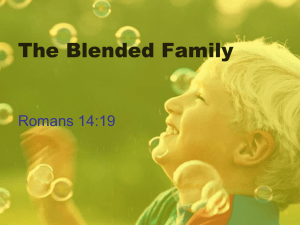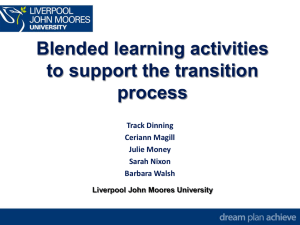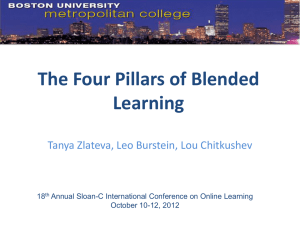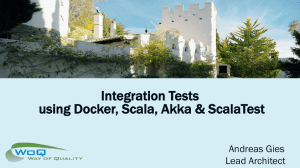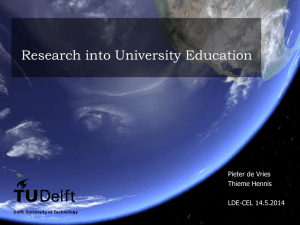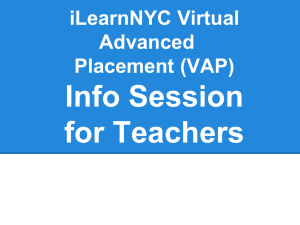Building upon assignment feedback with an
advertisement
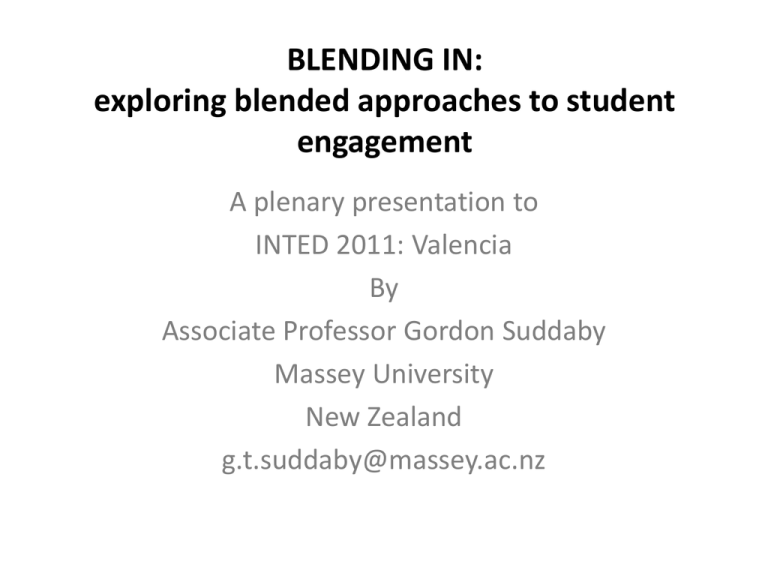
BLENDING IN: exploring blended approaches to student engagement A plenary presentation to INTED 2011: Valencia By Associate Professor Gordon Suddaby Massey University New Zealand g.t.suddaby@massey.ac.nz Project team: Massey University: Associate Professor Lynn Jeffrey, Associate Professor Gordon Suddaby, John Milne, AUT University: Dr Andrew Higgins, University of Canterbury: Dr Keith Comer, Lincoln University: Dr Helen Gilmore, And The late Associate Professor Mark Laws of Te Whare Wānanga o Awanuiārangi About the project Project Title: Help or Hindrance - Blended Approaches and Learner Engagement Project Aim: to identify effective student learning strategies in a blended environment. Funded: Through the national project fund, 2010 of Ako Aotearoa, NZ’s National Centre for Tertiary Teaching Excellence (www.akoaotearoa.ac.nz) Project Outcomes: • Strategies to be tested in four organisations • Case studies for each participating institution • Briefing papers relevant to each institution and the wider sector. Project focus To: • Identify student learning strategies in a blended environment • Identify factors that enhance student and staff engagement in a blended context • Develop strategies enabling teachers and institutions to give pedagogical support to enhance learner engagement and achievement. • Develop and test a toolkit of engagement strategies, • Refine the toolkit to facilitate student engagement (and re-engagement) • Describe engagement strategies in terms of teacher intention and student response Key project outcome In developing a toolkit to facilitate student engagement through effective blended approaches to teaching and learning it is intended that the toolkit will include strategies that: – minimise barriers to engagement in a blended context – enhance the quality of the engaged experience in a blended context – Support the engagement/re-engagement of students in a blended context who have either; • never engaged or • have become disengaged. Underlying premise • “the promises (and hopefully, the benefits) of blended learning are extensive”. Bonk, Kim, & Zeng,( 2009). • So, what do we mean by ‘Blended learning”? Online behaviour and assessment High Module Mark Low Low High Online use Maltby and Mackie, 2009 Model of learner engagement High Traditionalists Model Disengaged Geeks Overall Mark Low Low High Online use Maltby and Mackie, 2009 Defining blended learning? At its simplest, blended learning is the thoughtful integration of classroom face-to face learning experiences with on-line experiences. Garrison and Kanuka (2004) BUT... • Blended learning is becoming an almost ubiquitous notion! So, what do we understand by the term ‘blended learning?’ A moment to reflect... • What is your understanding of the term ‘blended learning’? Some ways of defining blended learning ? • ...blended learning environments combine face-to-face instruction with technology-mediated instruction Graham, 2006 • Blended learning describes learning activities that involve a systematic combination of co-present (face-to-face) interactions and technologically-mediated interactions between students, teachers and learning resources Harris, Connolly and Feeney, 2009 • In the cybercampus, students never meet ...it is completely asynchronous. ...course are of a blended modality: Fulkerth, 2010 • ...where course content and participant interaction is conducted at least partially online... Arbaugh et al, 2009 So what do we mean by ‘blended learning? • Our team’s initial working (and evolving) definition of blended learning separates the intentionality of teaching from the impact of that intentionality on the learners by talking about Blended Teaching and Blended learning. We still have some work to do around this, but at this stage ... • Blended teaching is a formal adoption of a range of teaching strategies involving pedagogy and technology aimed at developing intended learning outcomes in students. It is generally conducted by and controlled in institutions and characterized by approved methods using agreed technologies. Those engaged in blended teaching may have received instruction or help to develop their teaching strategies. • Blended learning is a purposive but usually informal activity undertaken by a student who engages a range of learning techniques and strategies aimed at acquiring knowledge, skills and attitudes of relevance to them. Some of the learning may be formal and some informal. The learning strategies may be influenced by teaching approaches but are not determined by them, nor are the learning strategies under the control of an institution. Our project challenge • To develop approaches which better align the actions and intentions of the teachers and their institutions to the expectations, activities, actions, contexts, skills and outcomes of the learners in the blended environment!!! What we are actually doing • Focussing on second year business courses (looking for a degree of homogeneity amongst the institutional cohorts!) • Inviting teachers interested in blended learning to participate • Seeking to understand teachers’ engagement strategies through a series of personal interviews • Surveying student perceptions and understandings re blended learning through online questionnaires and focus group interviews • Measuring student engagement, perseverance, outcomes and success • Developing the Toolkit • Comparing teachers intentions with student perceptions in the analytical phase Another challenge Developing a shared understanding among staff and engaging them in the implementing a ‘blended approach’. • The project is looking to contribute to such a shared understanding and then to make available a ‘blended learning toolkit’ for staff to use. • The project is also looking to embed the need and support for a toolkit within institutional practice What is the Blended Learning Toolkit? The Toolkit is for teachers -It aims to minimise barriers to engagement, enhance quality, enthuse the disengaged -It will have both an institutional and individual application Toolkit Components 1) Needs Assessment: -Course characteristics, Nature of content, learner characteristics 2) Course Planning Tools -Based on input from Needs Assessment -Planning rubric 3) Developmental Tools -Designing content, Communication & interaction strategies -Student support, Reflective activities, Diagnostic & formative activities 4) Evaluation and reflective tools (for teachers) Some individual tools supported by institutions... • “Traditional tools” (Fulkerth, 2010); – Email – The web – Podcasts – Powerpoint – Web-conferencing – Social networking etc – ... • But! Some Institutional “tools” at an organisational level • Release time for training • Technology mentors • Supplemental pay and awards • Access to real-time support staff • Faculty input into software selection • User-based technology assessment techniques • Departmental forums and support • Professional development programmes and staff • ... Georgina and Olson (2008) There are also Pedagogical tools at an institutional level • • • • • • Course design templates Lesson plans (Littlejohn and Pegler, 2007) Reusable objects (McAndrew, 2005) Frameworks (Garrison and Vaughn, 2008) Rubrics (Example included) ... Tools for measuring and enhancing student engagement and support We are developing a suite of these for the toolkit. Measuring engagement through: • Usage of online learning tools (VLE analytics) • Assessment (formative and summative) • Student perceptions (survey and interviews) Also: Engagement strategies... Engagement strategies 1. Curiosity: -Transitioning - make learners feel a part of the class AND the discipline, 2. Removing technical obstacles - Using checklists and help desks 3. Address student obstacles -e.g. Procrastination, Time poorness, Anxiety, 4. Social presence Teacher immediacy - visible and useful teacher participation, accessibility, web 2??? 5. Feedback -Teacher, transparent and timely processes - Student feedback, advice, help, self-monitoring tools 6. Learning Activities, e.g. online quizzes, challenge, problem solving, real world. 7. Content, Tools for designing lessons, structuring courses, Rules/guidance for writing 8. Personal contact, Strategies for early detection 9. Support, Direct student to other support staff –contact details on the website 10. Negotiated study, allowances to help students get back on board e.g. extensions. And in more detail... • A blended learning course review rubric E.G. developing a VLE site based on an approach used by Lincoln University (NZ)... Blended Learning Course Review Rubric (draft) Baseline Site Content 12 13 14 15 Welcome letter containing a brief introduction to the course and its content Effective Short video of a member of the teaching staff introducing him/herself and the course Course outline (LU Course content minimum content) in displayed as a course approved LU format map Topics have descriptive Consistent use of headings reflected in module and topic menu block . Course headings through the content structured as site and are linked via the course map modules with topics within (not weeks) Learning objectives at Explanation of how module and topic each topic contributes levels to the acquisition of Graduate Profile attributes Exemplary Series of videos containing updates, important points, links to real world events etc. Links from assessments to relevant sections in course outline Explanation of how each topic’s learning objectives and Graduate Profile attributes contribute to career Finally... Kanuka 2009 describes blended learning as “.. an option to remove time, place and situational barriers – while retaining the ability to provide high quality interactions between peers and instructors” No doubt many of your institutions have such tools in operation. We would certainly be interested in hearing from those willing to share and contribute to the work. Contact details Lynn Jeffrey Massey University, Auckland, New Zealand l.m.jeffrey@massey.ac.nz Gordon Suddaby Massey University, Palmerston North, New Zealand g.t.suddaby@massey.ac.nz Keith Comer Canterbury University, Christchurch, New Zealand Keith.comer@canterbury.ac.nz Andrew Higgins AUT University, Auckland, New Zealand andrew.higgins@aut.ac.nz Helen Gilmore Lincoln University, Christchurch, New Zealand helen.gilmore@Lincoln.ac.nz John Milne Massey University, Wellington, New Zealand j.d.milne@massey.ac.nz,

